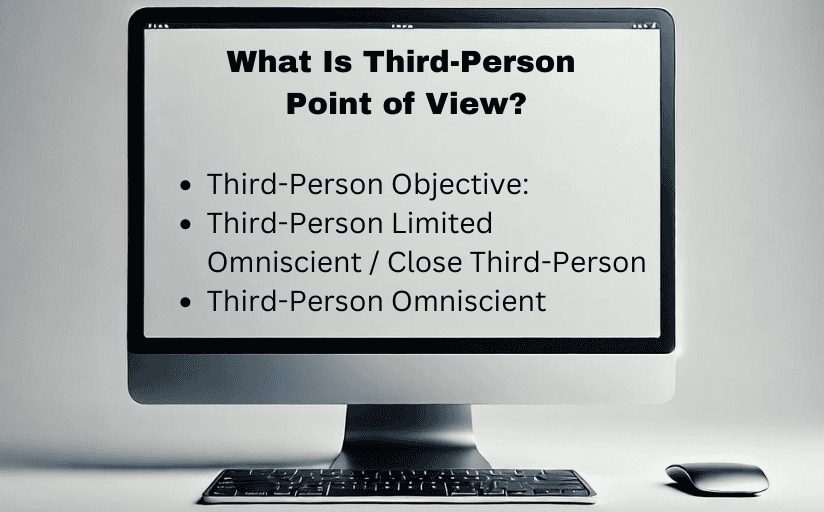As a writer, you’re constantly thinking about how to up the ante when creating copy. After all, the content you craft has a real impact on clients’ businesses, so you’re always trying to deliver the perfect landing page. Of course, there’s also the pride of a job well-done—this is your craft, after all. In that vein, let’s talk about something you may have thought about when looking over content instructions: Is the best website copy first- or third-person?
(If you make a purchase using the links in this post, we may earn a commission.)
Should Website Copy be in First or Third Person?
The most difficult thing about this question is that the answer has changed over time. When the internet first became widely available almost 30 years ago, there was no standard for writing web pages. Nowadays, we adhere to the AP Stylebook and its updates, but back then, it was a literary free-for-all. Users applied their print experience to the online sphere, only to have new experiences shaped by the introduction of social media, emojis, and rapid shifts in internet culture.
BUY – The Associated Press Stylebook: 2024-2026
All that said, there is a definite answer today, though it’s not the simplest. Is the best website copy first- or third-person? Well, it depends. Most people consider it a hard-and-fast rule to write in first person when creating a webpage. While this is great guidance for most situations, of course there are exceptions. (Would it be English if there weren’t?) So, for a more thorough answer to this inquiry, let’s take a look at each point of view and what you can accomplish with it.
Third Person
Third-person POV is commonly used in technical and academic writing because it’s considered more formal than first person. This may be why some people think third-person is the best perspective for a landing page—after all, you want to sound professional when addressing customers. But should a website be written in third-person, given what a website aims to do? To figure this out, let’s break down what third-person point of view is and what it does.

What Is Third Person Point of View?
Third-person point of view separates the narrator and the subject. In laymen’s terms, the person talking and the person being talked about are different. Pronouns used for third-person perspective are he/him, she/her, and they/them.
To complicate matters, there are three types of third-person POV. So the question isn’t merely, “Should a website be written in third-person perspective?” but, “Should a website be written in any of the third-person perspectives?”
Types of third-person perspectives
Before we can answer this question, of course, we need to look at the three third-person POV types separately:
- Third-Person Objective: The narrator merely reports what is happening, with no insight into the emotions or thoughts of the characters.
- Third-Person Limited Omniscient / Close Third-Person: The narrator tells the story from a particular character’s point of view. Which character used may change from scene to scene but differs from third-person omniscient in that the narrator only knows what the character knows while within that person’s perspective.
- Third-Person Omniscient: The narrator is privy to the emotions and thoughts of all characters, as well as information the characters themselves don’t or can’t know.
Now let’s look at our revised question: Should a website be written in third-person objective, limited omniscient, or omniscient? Of all the options, third-person objective seems the most likely, as it relies on facts and keeps a neutral tone, both of which are considered professional. Third-person limited omniscient and omniscient, on the other hand, are all about subjectivity and don’t make sense for a landing page. After all, there are no stories being relayed and, therefore, no characters to be referenced.
Except, what if there are? Companies that have been around for a long time generally change hands, which means their “About Us” pages may contain stories of their founders and history. Should a website be written in third-person omniscient or limited omniscient on this specific page? It’s possible, but only when portraying emotion is beneficial to the content.
While third-person objective can be used on the “About Us” page, many brands prefer to describe their founders’ beliefs, dreams, and emotions, which don’t lend themselves to third-person objective. Instead, you can use third-person limited omniscient to describe the founders’ journey, or third-person omniscient to describe the company’s growth through the founders’ work. This provides opportunities to develop the brand voice and emphasize the company’s values.
What Are Some Examples of Third-Person Point of View?
We’ve discussed each of these POVs in abstract concepts, but to write website copy in first or third person effectively, you need some examples.
Here are a few examples of third-person objective:
- The company ships worldwide and has stores in over 30 countries.
- As the founder, Jacob Smith set the company culture, which continues to this day.
- Customers can experience many benefits, including prompt assistance and excellent service.
In comparison, here are examples of third-person limited omniscient:
- The company is proud to ship worldwide and offer stores in over 30 countries.
- As the founder, Jacob Smith felt a positive work culture was crucial to productivity.
- Customers are happy to report prompt assistance, excellent service, and other benefits.

Here are a few third-person omniscient examples as you consider whether website copy in first or third person is better:
- Proud to ship worldwide, this company also delights customers with in-person stores in over 30 countries.
- The founder, Jacob Smith, was determined to leave his mark on company culture. As a result, employees enjoy a positive atmosphere at work.
- Customers consider prompt assistance and excellent service to be essential, which is why employers feel so strongly about customer-centric business models.
How Is Third Person Point of View Used?
Third-person was once considered the preferred method of writing résumés and other professional documents, but it has since lost favor. Nowadays, third person is usually relegated to fiction or technical writing.
Bottom line: Should a website be written in third person? In general, no—unless it’s more awkward to use first-person. Our previous example of the “About Us” page is such an exception.
How Does Third Person Point of View Affect the Audience?
Of course, the most important thing to consider when deciding on a POV is this: How will it affect the audience? When you’re writing webpages, your audience is everything. Will visitors find your tone knowledgeable or alienating? Is the opening friendly and inviting or overly casual and unprofessional? One of the hardest things about creating web content is falling on the right side of that line. Writing website copy in first or third person can affect this, which is why it’s such an important topic.
The main thing to keep in mind is that using third person of any type creates a separation between the reader and the narrator. When you’re writing for a webpage, you want to form a connection with readers, not keep them at arm’s length. For this reason, the use of third-person POV is more often the exception than the rule.
First Person
You’ve likely read and even written quite a bit of first-person. It’s popular in fiction and used in more personal writings such as letters and journal entries. But does it belong on a webpage?
When you consider whether to write website copy in first or third person, you may be thinking about which is more professional. For a long time, first-person was considered too informal for professional or technical writing—in fact, this is sometimes still the case in print. However, creating content for the internet is a completely different ballgame.
Connecting with your audience is the entire point of webpage content. Whether the purpose is to sell a product, inform the reader, or solidify branding, the first thing a webpage must accomplish is establishing a relationship with visitors. There’s no question that using the first-person POV is an ideal way to do so.
But why is this so? Why should this be the obvious answer when considering whether to write website copy in first- or third-person? To explore these questions, let’s first start with what a person’s point of view actually is.

What Is First-Person Point of View?
In the first-person point of view, the narrator and the subject are one and the same. In other words, the narrator is relating the story from her or his point of view. First-person pronouns “I” and “we” are used in this context.
Just like with third-person POV, there are multiple types of first-person perspective: central and peripheral. First-person central point of view describes stories in which the narrators are the protagonists. First-person peripheral point of view describes stories in which the narrators observe the protagonists.
How does all this help you determine whether to write website copy in first or third person? As mentioned before, there are circumstances where first-person may be more awkward than third. Generally, first-person peripheral can be easily substituted with third-person, unless there’s a specific reason not to do so. So what might those reasons be?
Generally, first-person peripheral is a stylistic choice used in creative writing. One such example is Thomas Mann’s Doctor Faustus, which details the protagonist’s descent from genius to madness, as observed by the narrator. That said, you may wonder if such a stylistic choice may ever be appropriate when writing website copy. To explore this idea, let’s first consider examples of these two very different points of view.
Examples of First-Person Point of View in Web Copy
Writing first-person central is relatively easy, especially for a website, as you can see from the following examples:
- We’re proud to offer the highest quality customer service.
- As a professional plumber, I know that quick service is essential during an emergency.
- For over 25 years, we’ve served our community.
Though not as common in web content writing, you may happen upon first-person peripheral examples similar to the following:
- Our customers report the highest quality service.
- As a professional plumber, I’ve seen how emergencies decimate homeowners, who have to then find accommodations on short notice.
- For over 25 years, we’ve watched the community thrive and expand.
The interesting thing about first-person peripherals is that they can often be replaced with third-person quite easily. In fact, third-person may be more compact and the better choice for your website.
How Is First Person Point of View Used?
Both kinds of first person point of view are often used in fiction but can make an appearance in professional writing as well, including:
- Emails
- Witness accounts
- Personal statements
- Academic writing (sometimes)
How Does First Person Point of View Affect the Audience?
Why does first-person build a connection with the reader? By its very nature, first-person perspective puts the audience in the narrator’s shoes, encouraging readers to identify with the “I” or “we” being used. This is a shortcut to empathy, which in turn can build trust and loyalty. Of course, poorly executed first-person POV can sabotage this effect, but generally speaking, content written in first-person has a head start when it comes to building a connection.

What Is the Best Point of View To Use in Website Content?
When deciding whether to write website copy in first or third person, the first thing you should consider is whether you want distance between you and the audience. If you want to bring readers close to you, first-person is the best choice. If you prefer to create distance, you should go with third-person.
However, it’s important to note that even if you decide on first-person, you’ll likely end up using third- and second-person pronouns throughout. In fact, I’ve done so in this very article.
This is especially true of the second-person point of view; since you’re writing as the company, you’ll likely directly address the reader, just as I am doing now. This doesn’t mean you’re no longer writing in first-person—it’s simply one of the complexities of the English language.
That said, to keep your goals in mind as you write, you should create a narrator persona before typing a single word. Deciding to write website copy in first or third person isn’t just about pronouns—it’s about who you’re speaking as.
So, start writing with that in mind and allow yourself to be flexible. As you revise, if you find instances of third-person, you shouldn’t feel compelled to change them. In fact, much of first-person, when written correctly, reads as third-person. As long as you keep a consistent tone and emphasize your connection to the reader at strategic points, you can absolutely use a mixture of perspectives.
What do you think? Is the best website copy first- or third-person? Leave a comment telling us how you use first- vs. third-person in your own work.


Leave a Reply